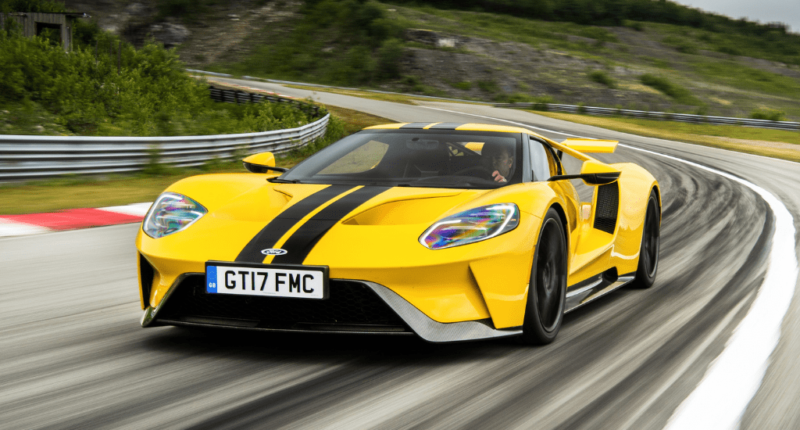We got the opportunity to put the Ford GT through its paces around M-Sport Ford’s brand spanking new test facility at Cockermouth in England back in 2019. It was our first introduction to the Blue Oval’s flagship model and one that left quite an impression.
The words ‘poster car’ and ‘Ford’ are not ones that tend to be uttered in the same sentence. McLaren, Porsche and Lamborghini are what you often find hanging on the bedroom walls of teenage boys who dream of getting the chance to either own, or drive, one in their lifetime.
Times are different now, however, and the Blue Oval has featured more prominently thanks to the GT – a supercar that was reinvented to celebrate the fiftieth anniversary of it beating perennial rival Ferrari at the Le Mans races.
A tsunami of positive media hype has surrounded this week’s test car, so we decided to grab the keys from Ford and decide if it is all completely justified. The car, as you can probably tell, is no ordinary, run-of-the-mill Ford model.
In corporate speak the GT supercar is a “technology showcase” from the same Detroit-based company that designs and builds the Fiesta supermini, the Ranger pick-up truck and commercial Transit van. Can you think of another mainstream rival that sells such a diverse range of cars? Nope, me neither.
Styling aside, the GT is special for two reasons. Firstly, you must apply to become an owner. Before the last window closed over 6,000 applications were received, with 500 of these from interested parties here in the UK. Secondly, production of these two-seat high-performance cars has been capped.
Only 1,250 are ever going to be built at a cost of £420,000 making it incredibly exclusive and also incredibly rare. The GT is not all mouth and no trousers, though. The road and race versions that won their class at the 24 hours of Le Mans were developed side by side, so anything the endurance car got the production version did, too. The low-stance body of the showroom GT is awash with active aero wherever you look.
For instance, the B-pillars not only add strength to the chassis but guide air over the car’s haunches to push it down onto its wheels; the rear lights are hollow to allow hot air from the intercoolers to escape; and the deployable rear wing doubles up as an air brake that changes angle to help the driver in the teardrop-shaped cabin maximise its on-track capabilities.

Then there are those fat, bespoke 245/35 R Michelin Pilot Sport Cup 2 tyres at the front and even fatter 325/30 R20s at the rear that serve up unbreakable traction come hail, rain or shine.
As you walk towards the GT in all probability your heart will immediately begin to beat faster, the palm of your hands will turn sweaty, and the whole of your mouth will become as dry as Gandhi’s sandal.
Sitting on a smart suspension that can drop the body 50mm to a 70mm ride height in seconds adds to the drama, the wheels sucked so tight to the arches that you are left wondering if there is the room for them to turn.
Pull on the small flush handle positioned below the fuel cap, and this opens the butterfly doors. Getting in and out (even for someone as small as me) is anything but easy. You must rest your bum on the edge of the GT’s carbon tub and use your hands to swivel around into the driver’s seat.
Once there a small strap on the side of the lower console is pulled to move the steering rack and pedals forwards or backwards. The seats do not move because they are fixed to the carbon-fibre tub, although they do recline to assist taller drivers. Once you feel comfortable and have snapped your four-point harness in place it is time to hit the red start/stop button.
There is a sense of familiarity to the GT’s cockpit which, depending on how you view it, is either a good thing (ease of use, for instance) or downright bad (cost-savings). Certainly, there is not the same wow factor as, say, a McLaren 675LT on which the Ford GT was benchmarked against.
The steering wheel is an unusual shape and at the three figure speeds we are just minutes from hitting, a little too busy. We get that this is supposed to be as real as humanly possible to the competition equivalent but not everyone has the brain computing abilities of Lewis Hamilton.
Trimmed in Alcantara and hexagonal in profile the only function we must worry about around the 2.5Km of track is what mode we are going to be in. After a brief discussion it is decided to err on the side of caution and turn the small, knurled knob to ‘Normal’.

Don’t be fooled, though – this is no killjoy. OK, so the throttle and transmission are set for everyday driving and yes, the traction and stability control are on, but you can still have a decent rattle in this 647bhp masterpiece.
As you pull away there is a genteel growl from the all-aluminium V6 EcoBoost lump. Initially, the steering is heavy in your hands and the machined billet aluminium shift paddle marked with a ‘+’ demands a firm tug; a subtle pull back using an index finger simply won’t cut it on this occasion.
As we make our way around the first right hand turn the track opens up to reveal a quarter mile straight, so I don’t have to wait long to hear the growl of that twin-turbo, 3.5-litre motor which is mounted just inches from my right ear.
At this point there is only one thing to do: floor it. And with that you are launched towards the horizon, each shift up the gearbox dispatched in the blink of an eye, 130mph flashing on the digital binnacle as the forward thrust intensifies.
Equally impressive is how calm and controlled the GT is at these speeds – proof that the aero devices are indeed doing what man intended – and the relentless bite of the carbon ceramic discs at the front. The rear brakes are also cross-drilled and rely on four-piston Brembo calipers.
Our ‘GT17 FMC’ car has been a living, breathing, working example for three years now and in that period it has clocked up over fourteen thousand punishing miles in the hands of the world’s press, yet the two-seater feels as solid and tight as the day it drove out the factory gates at Markham in Ontario, Canada.
SPECIFICATION
Price: £420,000 (as tested)
Engine: 3.5-litre, V6 twin turbo
Power/torque: 647bhp/550lb ft
Transmission: 7-speed semi-automatic, rear-wheel-drive
0-62mph: 2.8 seconds
Top speed: 216mph
Economy: 16.8.mpg
CO2: 225g/Km









